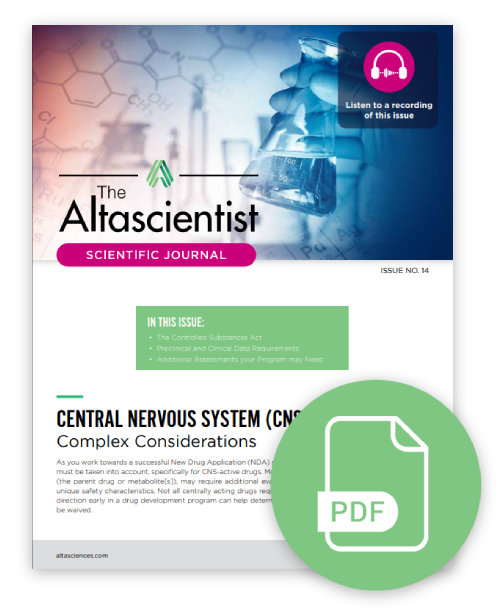ISSUE NO. 14 — Central Nervous System
As you work towards a successful New Drug Application (NDA) submission, there are many considerations that must be taken into account, specifically for central nervous system (CNS)-active drugs. Molecules or compounds that are centrally active (the parent drug or metabolite[s]), may require additional evaluations to characterize the drug effects and unique safety characteristics.
many considerations that must be taken into account, specifically for central nervous system (CNS)-active drugs. Molecules or compounds that are centrally active (the parent drug or metabolite[s]), may require additional evaluations to characterize the drug effects and unique safety characteristics.
Not all centrally acting drugs require additional assessments; however, strategic direction early in a drug development program can help determine whether such studies should be planned or can be waived.
In Issue 14 of The Altascientist, we look into the complex considerations of CNS-active drugs, including:
- The landscape of CNS-active drug studies
- Drug scheduling and the Controlled Substances Act (CSA)
- Reviewing data from early-phase preclinical and clinical studies
- Choosing a CRO for CNS studies
THE IMPORTANCE OF CLINICAL STUDIES FOR CNS-ACTIVE DRUGS
CNS-active drugs have unique attributes that necessitate additional specialized study, such as:
- Cognitive impairing/enhancing effects
- Reinforcing effects (abuse potential)
- Physical dependency and tolerance
- Additive effects (when combined with drugs and alcohol)
Because CNS-active drugs can have unintended effects in the critical neural system that influences so many aspects of human health, the required preclinical and clinical studies are typically more detailed and rigorous than for other types of drugs. In addition, the results of such studies will have a material impact on your development program going forward, both in terms of timelines and budget, so you will want the answers for yourself as much as for the regulatory bodies.
One of the key considerations in evaluating a CNS-active drug molecule (or its metabolites), is the evaluation of abuse potential. Such data is integral in determining whether or not a new drug approved for medical use may need to be a controlled substance. The FDA uses an eight-factor format for NDA submissions of CNS-active molecules.
A controlled substance is assigned a schedule based on whether it has a currently accepted medical use in treatment in the United States, and its relative abuse potential and likelihood of causing dependence. Physical dependence is a neuroadaptive process that can occur in the absence of abuse potential. The ability of a drug to produce physical or psychological dependence plays a role in the scheduling placement of an abusable drug under the CSA.
DRUG SCHEDULING AND THE CONTROLLED SUBSTANCES ACT
The Controlled Substances Act, enacted in 1970, provides a framework for appropriate labelling and controlled distribution of medications with certain attributes. Scheduling of a medication impacts market availability and prescribing behavior. For planning and development purposes, it is important to act on early signals that suggest scheduling will be necessary. Drugs and other substances that are considered ‘controlled substances’ are classified into five schedules.
As the schedule progresses from I through V, the abuse potential reduces and thereby the limitations on prescribing practices are lessened. Schedules I and II both represent drug molecules with the highest known abuse potential. Schedule I drugs are not approved for medical use in the United States, whereas Schedule II drugs are.
Explore all issues of The Altascientist in our Resource Center. And don’t forget to subscribe to “The Altascientist: Audiobooks” on Spotify, Apple Podcasts, or wherever you get your audio content.
Download publication